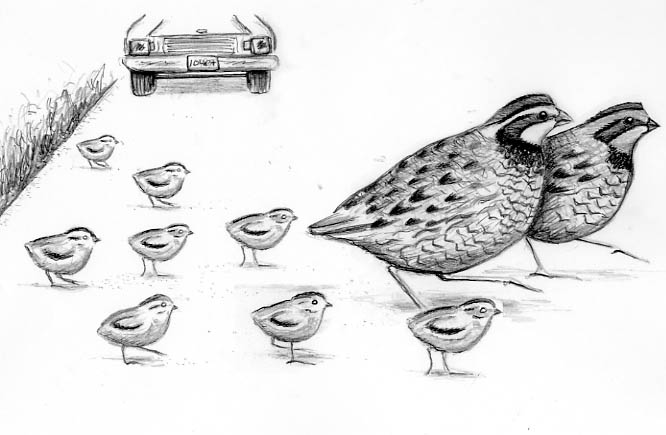
Dear Bird Folks,
I’d like to share a birding experience that I had this past week. I was driving along a side road when I stopped to let a pair of bobwhites cross in front of my car. Following right behind the bobwhites were several tiny mice. At least I thought they were mice. As I inched my car closer, the mice turned into baby bobwhites. I counted at least ten of them. Even though I was totally thrilled by the sighting, I couldn’t help but think that the middle of August was rather late for bobwhites to be having babies. Was this unusual?
– Brandon, Chatham, MA
I like your style, Brandon,
I’m talking about your style of watching birds from your car. As I get older, the notion of bird watching from the comfort of my car seems to have more and more appeal. I know that birding while sitting in a bucket seat appears to be the ultimate in laziness, and maybe it is, but hear me out first. While everyone else is zipping around with their car windows shut tight, the AC on, yapping on a cell phone and chewing on a bag of bilge that they have just gotten from a drive-thru, I’m listening and looking for something that might make me want to stop and focus my binoculars. As you found out last week, you don’t have to hike through woods, fighting ticks and mosquitoes, to see cool birds: you only have to keep an ear or eye out for them no matter what you are doing, even if it’s driving. And the best part is if you are looking for birds you don’t have to be watching the road while you are driving. Watching the road? How boring is that?
You were pretty lucky to see bobwhites of any kind, Brandon, let alone a brand new family of them. In recent years, the overall population of Northern Bobwhites has taken a dramatic plunge. By some estimates their population has decreased by eighty-five percent, and perhaps more. Why are the birds disappearing? Oh, I don’t know, maybe the fact that the U.S. population is now over 300 million has had affected the quail. But there other factors, too.
When Europeans first came to North America, they did what they do best: cleared the land for farms. The bobwhites loved the hedgerows that many of the farms created, and their population flourished. Unfortunately for the quail, those small farms are long gone and have been replaced by subdivisions and bilge-selling drive-thrus. The few remaining farms have plowed under the hedgerows, leaving very little area for the quail to nest in. In addition, other suitable habitat has become filled with the predators that thrive around us humans. Foxes, raccoons, opossums and cats have all added to the quail’s struggles. Ironically, the birds have found some relief from an unlikely source: Coyotes, the creatures that paranoid people love to hate, have kept many of the above predators in check and their presence has benefited the bobwhites.
Bobwhites build their nests on the ground, typically near a clearing. But if you think their nests would be easy to find, think again. The birds often weave grasses and other vegetation over the top of the nest, making it extremely hard to locate. The female usually lays a dozen eggs but if she is in a generous mood she may lay a baker’s dozen or more. Unlike turkeys, where the males mate and run, the daddy bobwhites are excellent partners. They stay with the female the entire time helping to build the nest, incubate the eggs, watch for danger and serve her pickles and ice cream.
Because the female doesn’t start sitting on the eggs until all of them have been laid, the babies all hatch out on the same day. Within hours of hatching the kids are up and out of the nest, never to return. The quailings need their parents for warmth for the first week or so, but they are totally capable of finding their own food from day one. Now, that’s the kind of kids to have.
I would like to think the flock of little ones you saw, Brandon, was the second batch of babies that the adults were raising this summer, and perhaps it was. But it also may have been a late brood from parents that lost their first nest of eggs to bad weather or predation. Whichever it was, it is indeed possible to see young bobwhites at all stages of growth anytime during the summer. No matter what the stage, the important thing is that you actually saw them. It’s nice to know that there is at least one family of bobwhites being raised on Cape Cod this summer. That’s great news. And the news is even better because over the past few weeks, I’ve had several people report seeing adult bobwhites that were being followed by “tiny mice.”
One more thing. If someone from the DMV happens to see this and reads the part about me not paying attention to my driving, they need to know that I only wrote that for dramatic effect. I’m a totally careful and conscientious driver. There, that should cover me, right?